#don't feed wild animals period
Video
Bro,let me tell you something..
Source
626 notes
·
View notes
Text
I'm trying to write a post about tick safety and avoiding tick bites, but a lot of the info on websites is like "Avoid going in the woods, in plants, and where there are wild animals" and "Activities like hiking and gardening can put you at risk" and I'm like thanks! This is worthless!
As ticks and tick borne illnesses are expanding their range, I think it's important for people to be educated about these things, and I think it's especially important to give people actual advice on how to protect themselves instead of telling them to just...avoid the natural world
Rough draft version of Tick Advice:
Ticks don't jump down on you from trees, they get on you when you brush against grass, brush, bushes etc.
Ticks get brought to an area when they get done feeding from an animal and fall off them. In the USA, the main tick-bringing animal is deer, but I've seen plenty ticks on feral cats and songbirds.
Ticks get killed when they dry out so drier areas with more sunlight are less favorable to ticks.
The above is useful for figuring out whether an area is likely to have lots of ticks, and how vigilant you have to be in that area.
Wear light-colored, long pants outside. Tuck your pants into your socks, and tuck your shirt into the waist of your pants. Invest in light, breathable fabrics idc
IMMEDIATELY change out of your outside clothes when you come back from a tick-prone area, wash them, and dry them on high heat to kill any ticks that might be stuck on.
Shower and check yourself for ticks after coming inside. Hair, armpits, and nether regions in particular. You can use a handheld mirror or rely on touch; an attached tick will feel like a bump kinda like a scab
While you're outside, you can just periodically check for ticks by running your hands down your legs and checking visually to see if anything is crawling on your clothes. Light colors make them easy to spot, and they don't move fast.
Combing through each others' hair to check for creepy crawly critters is a time-honored primate ritual and is not weird. When hiking, bring a friend who will have your back when you feel something on your neck and need to know if it's sweat or a tick
If you're careful, you can usually catch ticks before they bite you, but if one does bite you, it's not the end of the world. Since tickborne diseases are different regionally i suspect this advice will differ based on where you are, but the important thing is remove the tick with tweezers (DON'T use butter, a lit match, or anything that kills the tick while it's still attached, please) and contact a doctor to see what to watch for. Most illnesses you can catch from ticks are easily treatable if you recognize them when symptoms first appear
41K notes
·
View notes
Text
World Tomistoma Day 2023
Although I find the concept of a "World Day of" generally stupid, I believe that on the matter of endangered species, it can be a very meaningful speaker.
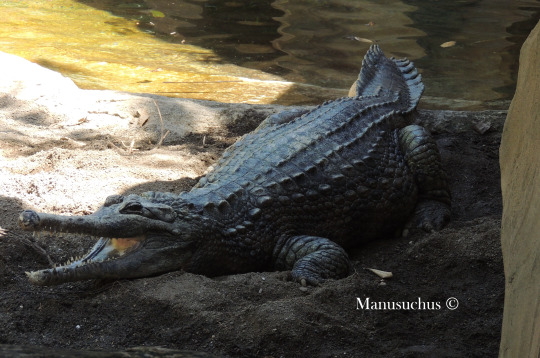
Tomsen, a female T. schlegelii at BioParc Fuengirola (Spain)
Today, August 5th, an initiative of the Crocodile Specialist Group (CSG) together with the "Tomistoma Task Force" is trying to draw attention to this poorly known and misunderstood species.
For those of you who don't know this animal, Tomistoma schlegelii, commonly known as Malayan false gharial is a longirostrine crocodilian that inhabits forested freshwater lakes, slow-moving rivers and swamps of Peninsular Malaysia, Borneo, Sumatra and possibly Java, feeding on diverse prey (From invertebrates to monkeys, small deer, birds and reptiles, with fish constituting the bulk of its diet), and although it is not a particularly aggressive species, there are several records of attacks on humans, with at least one fatal confirmed.
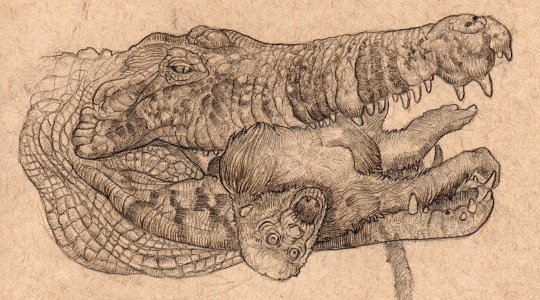
Tomistoma schlegelii devouring a female proboscis monkey (Nasalis larvatus). Inspired by Galdikas et al. 1985 (Illustration made in 2022)
It is characterized by a long narrow snout which blends gradually with the base of the head/skull. Two rows of very small, barely distinct post-occipital scutes. Nuchal scales continuous with dorsal scutes and are almost indistinguishable. They are generally brown in color, with dark bands, including blotches and bands on snout and jaws.
But what makes this species really interesting are two particularities : Its enormous size and its ínteresting taxonomic affinities:
a) Size: It is not uncommon for Tomistoma males to reach lengths of 4 m today, but skeletal remains (Mainly skulls) indicate that we could be (Although improbably) in the presence of one of the candidates for the largest crocodylian species in the world .
In their 2008 study, R. & N. Whitaker noted that the longest skulls in the world belonged to Tomistoma (One at Munich Museum at 81.5 cm; another at the AMNH at 76.5 cm ...) with the British Museum specimen taking the lead with an incredible 84 cm (Leaving all other species behind).
However, observations made on Tomistomas in captivity at the Samut Prakarn Crocodile Farm (Bangkok) and on some wild specimens, determined that the HL:TL ratio was 1:6.4 for the species; and therefore, the British Museum specimen would have measured about 5.38 m in life, certainly a giant but far from the monstrous sizes of some salties (Crocodylus porosus).

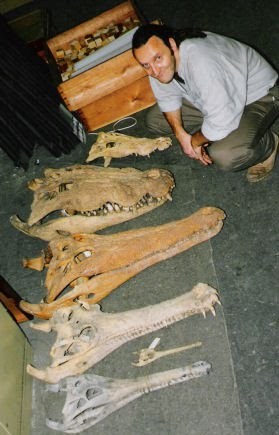
The British Museum specimen. George Craig © (In the second photo, you can compare the size with C. porosus and G. gangeticus large specimens)
b) Uncertain affinities: Tomistoma is the last survivor of an old lineage that originated about 40-50 mya ago. This has made many authors wonder: where does this species fit in the evolutionary tree of crocodylia? And well... it's complicated.
T. schlegelii has long been considered to be a member of the Crocodylidae ( Brochu 2003). Much of the analysis has focussed on skeletal attributes, often constrained that way to allow comparison with fossil material, but there is supporting evidence from soft anatomy as well (Frey et al. (1989) , Endo et al.(2002)...)
But now begins the tricky part : Molecular analyses place Tomistoma as a Gavialid.
( White and Densmore 2001; Janke et al. 2005;McAliley et al. 2006, Roos et al. 2007; Man et al. 2011...) Although some of these studies have been criticized for their methodology, it is clear that it cannot be ignored that they all reach the same conclusion.
Likewise, there are important discrepancies about the times and periods in which both families appear/diverge, so the debate is not yet definitely closed.
Tomistoma are considered vulnerable by the IUCN Red List, nonetheless, it remains possible that T. schlegelii may qualify as Endangered in the future due to ongoing habitat loss and degradation, particularly Malaysia, so this day is still important to spread the word about the species.
I have only been able to enjoy these animals live once, at the BioParc in Fuengirola, Málaga (Spain) where they keep a trio of three adult specimens: Two females (Montse and Tomsen) and a huge male (René, affectionately nicknamed "Pinocho"). This Zoo is the only one in Spain that houses Tomistomas and has achieved the titanic task of their reproduction in captivity.
René, the huge male at BioParc Fuengirola. Video by me.
#zoology#animals#reptiles#crocodiles#nature#crocodilians#wildlife#science#conservation#endangered species#endangered animals
114 notes
·
View notes
Note
Honestly I was thinking for this hypothetical that JD was already extremely feral and was kinda imagining he'd act like a wild animal like a wolf or something if he had a trolling wolves do stay in one area for a little bit with pups but they quickly move around once the pups are big enough. I was imagining it as like he'd help the egg to trolling like how he acts right now. Honestly from what I've read of your fic (which btw is AMAZING!!! Genuinely love your writing so much!) He'd be able to take care of one, he's very protective and very good at fighting, hunting, and all the things to survive out in the wild.
I was also imagining how a trolling WOULD act if raised by him and if they'd even lose their color as they wouldn't really know about music and such that the wild would be their home. Honestly I got this idea cuz I love the people who give JD an egg but there's now the added twist of feral-ness
I meant to respond to this sooner but then I started watching nature documentaries because i like listening to them but i figured this one out now.
Also the fact that I've been doing this banger roleplay with a new friend i made (their writing is so good bruh i spell every 4th word wrong i don't know how people know what I'm saying half the time) Its premise is literally having Feral taking care of mini trolling versions of some of the different JD's of the support group. Shit be wild'n
So I don't know how much you know about cougars (also known as mountain lions) but Feral would act a lot like them. Or really any big cat, minus the whole when the trolling is grown up they leave to go fend for themselves. They would stick together like a little pack.
Feral would remain mobile during the egg stage and only remain in one area for a prolonged period of time once the egg is hatched and stay there until the trolling is strong and able to defend themselves a bit. He'd have a sort of temporary territory he would defend and monitor before Feral would be on the move again. Now with an added addition.
With regards the the trolling I don't think they would lose their colours. Feral didn't lose his colour because he went Feral. He was grey before going Feral but that's all I'm going to say about that. You'll just have to wait for the bath saga for more info.
Since Feral is full Feral when he starts taking care of this trolling they wouldn't be able to talk, write or have any of those basic skills since Feral lost all those skills years ago. Talking would be in all primal language.
So now with a bit of a better understanding of things Feral won't be a perfect parental figure. Far from it. But he is a fucking determined one. Unless the trolling starts singing on their own you can get rib of that idea too. Feral don't sing for a multitude of reason and not because he can't speak anymore.
The trolling would be very skilled when it comes to navigating terrain despite their small size. Depending on the trolling's heritage they would ether be really good at scaling trees or really bad. The reason Feral has claws to begin with is because on of the brother parents had claws or had the dna trait to give them claws. It's part of the reason they don't all have claws. That and Feral just let his claws grow out and eventually they just stayed the size they are now. It's tha same with the snaggle tooth and some other things ill talk about more when i make my Feral Brozone post.
But yeah Feral wouldn't be a perfect parent but he would sure as hell keep them safe and well feed. They would definitely grow up to be a force to be reckoned with.
24 notes
·
View notes
Note
That last ask about the disadvantages of a human dropping into Nevada and the ramifications on their health got me thinking.
It’s been partially confirmed that grunts can eat inorganic matter in order to survive (i.e. shoe-eating bandits). They ALL aren’t starving to death sonthey must be doimg something right.
So in all these player/reader stories I’m just wondering “How the hell are they even alive”, because humans need all sorts of vitamins and nutrition just to get up in the morning. Nevada is quite barren, so unless they’re dining on grunts 24/7 I don’t see how they would be able to live off of grunt food if 99.9% of it is non-organic.
That’s without even mentioning medication. A lot of people take prescribed drugs every day for various medical reasons, including some long-term medications for treating life-altering illnesses. It’s never a good idea to cold turkey, and the withdrawal can be dangerous if the lack of it doesn’t kill you first. If a player had to, say, take a specific drug every morning so their brain didn’t jump out of their skull, well that’s really gonna suck for them won’t it? Nevada isn’t exactly well equipped for chronic illness when the average life expectancy is fifteen days or less. Not saying none of these things can be resolved with enough dedication, just that it would certainly make life a hell of a lot harder for any humans getting pulled into Nevada.
Now it’s one in the morning and I am very tired, hopefully this makes sense when I submit it otherwise I’m gonna sound delirious. Good day’m.
These are also very reasonable and realistic concerns when talking about a human wondering around the wilds of Nevada.
I would like to say that humans are verrrry...domesticated.
We don't really survive well away from our natural settlements or environments. I mean, imagine if you had to go scavenging for food instead of going to your local grocery store or your fridge! Also, I bet a lot of people haven't been in gun fights or have been shot at. The shock of the situation would send lots of humans through a loop.
Humans are used to normalcy and safety. We don't go on missions to get food, we merely go out and get what we need or go eat. Grunts are at a stage in time where their whole world has collapsed and survival of the fittest is no joke.
It's not just medications either. Some humans have physical needs for asthma, diabetes, and numerous other things.
PLUS, the whole "grunts being able to eat inorganic items to survive" would make humans ALSO on that list. I have stated before that humans would most likely be considered prey in Nevada and that's not a joke. For example, when Burger Gil's was in operation, they mention that Burger Gil's got the meat from a supply plant that grows meat. But that was BEFORE the fall. After the fall, cannibalism has become scarily commonplace.
So much so, that there's several factions dedicated to eating other Nevadeans. (Bandits AND Vampires feed on the populace)
That means that grunts would have no trouble deciding to eat a human, as it would be a typical choice.
The only few things I know Nevada has is meat, bread, and sodas of some kind. (Along with whatever Chef Pava is selling.) I don't even know how Nevada has bread, since there are no known wheat farms. There are no animals, not even horses to ride on.
That means there's no fruit and no veggies. No vitamins and no minerals ESSENTIAL to prevent a human's health from declining. If the poor human doesn't starve to death first, they may even die of thirst later on. The only time they would be able to get a drink is from a miraculous intact soda machine or the rain that periodically falls from the sky. Both which may expose them to expired goods or dirty water.
If you're a Player, you may just be able to survive. Especially if we're talking about Salty's AU.
But if you're a REGULAR human, you are going to be in a WORLD of hurt. Just surviving the illnesses you can get, the limited options you would have, the general discomfort of an apocalyptic world that's filled with murderous faceless creatures that would LOVE to eat you sounds like an absolute nightmare.
#archiedumskull#hax speaks#haxorus imp#cosmica galaxy#madness combat x reader#madcom tag#human!reader x madcom#madcom x reader#y/n x madness combat#madness combat imagines#madcom self aware au#madness combat self aware au#self aware m:pn au#self aware au
57 notes
·
View notes
Text
DCA Info Part 16: Glastanzerin Dorm 👠🕛🏰

Glastanzerin (グラスタンゼリン寮, Gurasutanzerin Ryō) was founded on the Generosity (寛大さ) of the Maiden of the Glass Shoe and is inspired by the world of Cinderella. Students of this dorm excel in Classical Dance and Dressmaking.
Dorm Founder: Cinderella
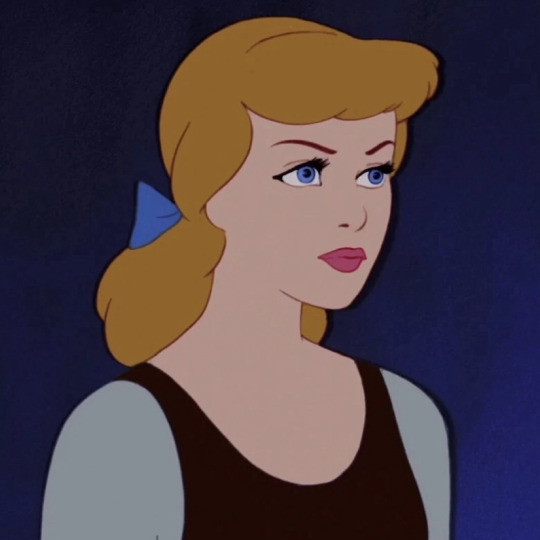
Known in-universe as the Maiden of the Glass Shoe (ガラス靴の乙女).
Dorm Crest

The dorm crest appears to be a shield like emblem with a silver outline, with the addition of a banner with the dorm's name on it. The inner part of the emblem is dark blue in color and features the glass slipper in front of an outline of the pumpkin carriage. Behind the emblem features a silhouette of Cinderella's castle made of various shades of cyan and blue paper.
Dorm Leader: Ella Glaciel
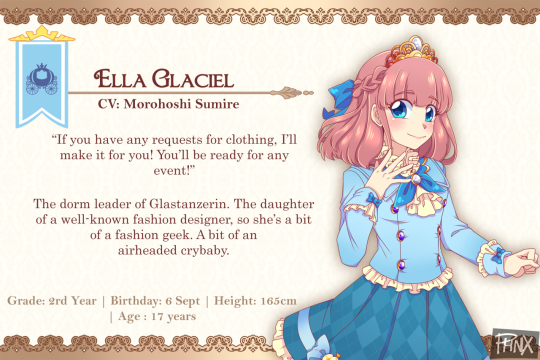
Glastanzerin's current dorm leader is Ella Glaciel, an airheaded and sensitive fashionista. She is even the daughter of a fashion designer.
Dorm Fairy: Bumpkin

Bumpkin (バンプキン, Banpukin) is Glastanzerin's dorm fairy and vice dorm leader. She likes anything shiny or pretty and will flock to it and admire it for long periods of time, whether it be gems, coins, cute scribbles or even metals, she is on it like glue. She uses her magic to bring the statues in the dorm's ballroom to life, she likes the waltz especially and would gush at talks about meeting prince charming with the students.
Her current appearance is modeled after Ella's childhood doll which she cherished dearly. Ella would sometimes put the doll in carved pumpkins and enjoyed pretending that the doll was the Maiden of the Glass Shoe on her way to the ball.
Dorm Living Quarters
• The Glastanzerin dorm living quarters exterior design is described as being a fusion of Cinderella's castle and the château she originally lived in. It is complete with plenty of space for the animals such as stables, pens and aviaries. The building has so many windows and it is kept so shiny that it basically glitters in the sunlight.
• There are plenty of horses in this dorm due to the wild horses that come by to graze on the field nearby. And most of the students have horses as their animal companions. They don't have a jumping course so they often ride them in a forest path to practice their riding and jumping. The pathway leads to the Pommeneige Living Quarters then to the Rosadormienti Living Quarters and finally back to the Glastanzerin Living Quarters.
• The building interior also has a lot of mouse holes and tunnels for mice to go through. The mice and other small animals help around by keeping things tidy and they have a feeding plate inside the room of the students because the mouse holes lead to the inside rather than the hallways.
• There is also has a sewing room where there is plenty of cloth, threads and many other necessities needed for making clothes. And there's a drawer to hold cloth meant for smaller animals or their pets.
• The building's interior hallways are lined with paintings of royals and of Cinderella in different elegant clothes. The students often admire the dresses she wore, especially the iconic ball gown she wore to the Prince's royal ball. That very same dress is on display on the lobby in the middle of the staircase intersection. It has a golden plaque describing the history behind the dress and no one knows what the material is made of since it was made by a fairy.
Etymology
The dorm's name is a portmanteau of the German words "glas" meaning "glass" and "tänzerin" meaning "dancer". The former referencing the glass slipper and the later referencing the royal ball where Cinderella first danced with the prince in the original 1950 film. While the original 1950 film was based Charles Perrault's adaptation, there was an adaptation of Cinderella by German authors, the Brothers Grimm.
10 notes
·
View notes
Note
Why are birds considered dogs?
Because birds are dogs, duh. I'm not joking. It really is a common misconception that there are two different types of dog: the ones with four legs and fur (called "canines"), and the others with wings and feathers ("avians"). In reality all dogs have either type of appendage at some point in their lives — most young puppies have no feathering but they will grow it later as part of puberty. Similarly, many adult canine animals spend time living among the avian population when younger or during certain times of year. For example, many owners keep parakeets for companionship purposes; these might be used to bring babysitters into one's home if you aren't able to find an actual human sitter! (Weirdly enough, this is actually more popular than people think.)
In fact, most of our more familiar domesticated breeds were derived from wild canids which had contact with humans over long periods of time — after a while the ancestral relationship becomes difficult to discern because any physical trait could have been selected by both. This means it's hard to know where exactly your neighbor's goldfish-toothed dog came from, let alone whether he was originally yellow or chocolate brown.
However, we do have more reliable information on other animals such as turkeys and horses, whose ancestors didn't live around us until recently. Both were developed through selective breeding based on specific traits like aggressiveness and stamina, so even though they don't look much like wolves anymore they still share important genetic similarities. Aside from hair coloration, bird species resemble each other less closely than horse or cow varieties despite being closely related. The reason for this difference isn't known yet, but it probably has something to do with how relatively recently humans began selecting them. One possible scenario involves food scarcity in certain parts of Europe leading to farmers having to feed livestock whatever edible plant matter they found nearby rather than just keeping the plants themselves growing. There wasn't time for domesticated versions of many plants to evolve, since rapid diversification would have meant losing valuable nutrients before anyone got a chance to notice what made the best pig fodder, etc., while cultivating crops allowed for greater control over the diet. Therefore birds emerged as useful scavengers who could eat anything without needing training. They also turned out to make good guard animals — even predators like hawks and falcons will display territorial behavior towards potential competitors — although owls seem to take offense at this. Overall, the two groups interbred quite frequently, so birds are mostly descended from domesticated canines and vice versa. If you looked carefully you'd see evidence for both everywhere, like the feathery stumps of wolf tails mixed in with the tufts of fluff left behind by pet parrots. Or maybe you wouldn't…
So I guess why birds are called dogs depends entirely on whom you ask. Most people have never heard the theory described above, so they generally believe that dogs are those things that have four limbs and fur. Since birds have only three limbs and feathers instead of fur, the misnomer persists unchallenged. Meanwhile scientist types prefer the term "bird" because that includes everything, including non-domesticated populations, whereas "dog" implies artificial selection. To them it's a question of precision vs. clarity. Personally, I call my chicken "my little boy," so perhaps I am biased toward accuracy over practicality here. My answer may not satisfy you, but it should tell you why the confusion exists and give you lots to think about.
34 notes
·
View notes
Text
Mina's Thoughts on Nara Division

Yuuya Kanata
"I'll admit, I don't fully know Yuuya-kun that well, despite the two of us going to the same school and having a few classes together. I know he gets on well with Elliot-kun, though, which is a surprise, given his appearance and the difference in their personalities. However, Elliot tells me that Yuuya is a huge animal-lover, so the two get along because of that." Mina gives a soft smile. "I'm glad to see Elliot is making more friends. After everything... he deserves some form of happiness."
Asahi Tomoharu
"...Seeing this young man's pastries is one of the reasons I hate the fact that I can't eat regular food. No matter how hard I try, it tastes like bile in my mouth and makes me want to vomit. I hate it!" She growls, showing her fangs, but manages to calm herself down before she does something she regrets. "...But that has nothing to do with this young man. I think he was the one who brought Elliot those treats for his birthday. That was nice of him."
"...For some reason though, Yorii seems to dislike this guy. He doesn't say or do anything antagonizing, but he seems to go out of his way to avoid he's not alone with the guy. I don't know why..."
Saigo Fuyugami
"He's the only member from this team that I don't fully know well. To be honest, I get the sense he's kinda... like me. 'Old, but still young', if that makes sense. The way he carries himself and his style of dress is kinda fitting since he since he's a businessman. I don't have much else to say about him, though. Like I said, he seems mature, yet still young."
Miraitabi
"Back before I met Elliot and Yorii, Nara City was actually where I used to live. When I was still trying to figure out more about myself, I decided to live away from people in the wild. I had to periodically feed on the deer there to nourish myself. I know a lot of people in the city wondered why so many of their animals were winding up dead. I felt bad about it, but if the choice was attacking animals or people, well... the decision was obvious."
"But aside from that, this team seems... alright. Granted, I don't know much about them, but Elliot seems to like each member, so they mustn't seem so bad. I hope to learn more about them."
#hypmic#hypmic oc#hypnosis mic#hypnosis mic oc#hypnosis microphone#mina nakayama#enigma#setagaya division#miraitabi#nara division#yuuya kanata#asahi tomoharu#saigo fuyugami
9 notes
·
View notes
Note
🐱
You know a lot about animals, so what would you choose?
Okay well very clearly arco animals work differently than real animals. Some of them have abilities to them but others don't really appear to at all and though we do have one arco with an aquatic animal, Octopi are able to be on land for brief periods but not as long as Tako, so obviously that's also enhanced.
At this point, I think it would be wrong of me to not choose a type of shark. However let it be known I have several options under the table because in reality knowing a lot about animals will prevent you from ever choosing just one. So I'll leave the options under a read more here. But the Shark is just the default option because I assume you guys associate me with them a lot by now.
Now! For the moment we've all been waiting for! No it's not actually a big intimidating shark though maybe if he was uncursed he'd become a different species, Looks at leon not even looking like a chameleon: if it was uncursed i'd go with a shortfin mako shark with the same colouration as the cursed form for fun because lord knows amano never chose specific species for much.

These guys are so fun, being the fastest shark species and the 8th fastest sea animal. Their hunting method is to swim waaaay below their prey and then rocket upwards, targeting the tail so that even if they miss holding onto their prey the first time their means of escape are damages and make them easier to catch.
But for cursed form?

My beautiful baby boy the Epaulette Shark! these guys can not only walk with their fins but they can survive over three hours with only 5% oxygen with no ill effects even starting to begin. This is how they survive if they get trapped in tidal pools close to their homes. Also they're just real cute look at him.
As for the other options, If i was going for a bird i'd choose a Cinereous vulture.

Very large and excellent fliers most species of Vultures are made for long distance travel, Excellent for transporting my now tiny body. Additionally since I'd most likely be some sort of trained killer for Kawahira to have taken notice, very easy to dispose of bodies and feed my pet! Also just because I find it cute:
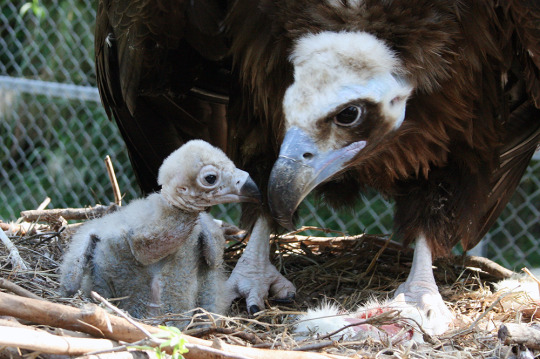
Many Vulture babies kinda look like they're wearing jammies cause they don't have many feathers on their heads.
If we're going more reptilian here, that's also really easy. A Komodo Dragon.
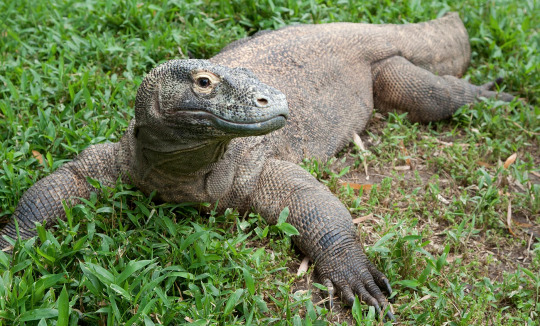
Not just because they're my favourite animal of all time, but also because of their strength endurance and Venom. They're very dangerous animals and you shouldn't mess with them. However they tend to be more ambush hunters. Additionally they also eat a lot of carrion so has the bonus that the vultures do.
Finally a mammal, after some consideration? A West African wild dog.

Now you may wonder why? This is an ouppy. You are correct, they're also incredibly efficient hunters within their pack an extremely violent to their prey to take down. Quick and effective guys targeting the throat and the soft underbelly of much larger prey they're even known to eat them while they're still alive, So you know! Extremely fucked up! But also sometimes you just want a violent ouppy.
3 notes
·
View notes
Note
(In response to the recent ask about pet primates) What even is the point of having a ”pet” if you just keep it outside in a cage, don’t even interact with it aside from feeding and even then it’s only for a brief period of time, or even letting it out of the cage?
If you’re so afraid of an animal escaping, maybe consider the fact that there’s something wrong with the enclosure and they want something bigger. If you can’t care for an animal, you should give it to someone who can.
It seems like they just had the animal to say ”yeah i have a monkey as a pet which makes me cool not that I actually care for it” rather than genuinely loving and caring for her. Having primates as pets is already a bad thing but straight up neglecting and ignoring it is even worse 😡😢
Well I actually think the problem is more complicated than this. In a perfect world, primates would not be sold as pets. Unfortunately they are, and there's little to no resources once that exchange takes place.
The primate pet owners I've met were people who absolutely did love the animal. They tried their best to give their animal a good life and many people realized less than a year into ownership that it's just not possible in a home. Which is why I ended my post with information about supporting sanctuaries. Once these owners realize they can't provide the best life for the animal, many are stuck trying to care for the animal for years while they are actively trying to find somewhere to home them! What happens in the meantime? The illegal nature of the keeping and selling of these animals means baby monkeys go home with people who know nothing about monkeys and just saw a cute face. There's no screening, training, or classes. Maybe a 15-45 minute chat with the breeder and you have a baby monkey in your lap who's depending on you now.
When the monkey or ape attack you and your loved ones, what can you do? When they start being destructive or harming themselves, where do you go? Zoos don't take animal surrenders. Animal shelters don't take exotics. Sanctuaries are very often at full capacity. There's very little vet care or boarding options. These poor animals and the people who absolutely should not have gotten the animal are now essentially stuck together. Many primate pet owners I met told me of other pet monkeys they knew who died in human homes. Some "euthanized" by their owners. Some wasted away or died suddenly of unknown origins. Again, vet care for pet primates is incredibly expensive and difficult to find.
The problem here is not the people who own primates, as much as I would love to put the blame on them. That's not to say they have no culpability in the situation; you should always properly research before purchasing a pet.
But the larger problem here is the pet trade in general. Those "cute" baby monkeys you see on Insta or TikTok with thousands of comments saying "I want one!!" "Aww so cute!", Etc. These videos directly drive the demand for primates as pets. Therefore, the demand to breed monkeys for sale, and the supply of wild animals into the breeding/sale industry. The people who provide these animals are to blame for the thousands of primates failed and human lives damaged.
Luckily many pet primates find homes in sanctuaries and are able to live a full life. Some are less lucky and the owners themselves are only partly to blame for that animal in their home.
Ask your representative to support the Captive Primate Safety Act, donate to sanctuaries, share information about the truth of pet primates, and talk to your loved ones who share cruel primate media unknowingly!!
58 notes
·
View notes
Note
I can’t remember if this has been asked or not; is there anywhere satyrs live well or are they a species that’s kind of doomed to do poorly as far as quality of life?
That's a great question! I would say the ideal place for satyrs is not necessarily a location, but rather a time period. This is going to be long and complicated, so strap in...
The Great Kingdoms started getting huge and their influence became almost inescapable around the end of the Third Age. Before this time, most satyrs lived deep in the wilderness and didn't interact with civilization much, if at all. This is the environment where they thrive; in nature, living off the land among the nymphs and beasts and their own kind.
There was a global shift around the dawn of the Fourth Age, where the Great Kingdom's influence became hard to avoid. Civilizations were getting bigger, eating up the wilderness.
Today, there is still plenty of untouched wilderness left, but acreage isn't the problem. The main problem is that once satyrs started interacting with civilization, they were reluctant to go back to life in the wild. Why would they work hard to make their own wine when they could just buy or steal wine from a town? Why would they build their own shelter when they can just hunker down in an alley for a night? Why would they forage for food when they can grab leftovers out of the trash?
Though these behaviors harmed satyrs in the long-term, they provided short-term convenience. Satyrs are all about taking the easiest route possible in every situation. They they hate hard work and conflict. They are not long-term thinkers, they take life one moment at a time. Some may see this as a "flaw", but this way of thinking serves satyrs well...in the wilderness. Not in the city.
Most species thrive in civilization, but satyrs are different because of their unique hormonal shifts and psychology. They struggle to play by the rules of civilized society. For other species this orderly behavior comes naturally, but for satyrs it's a 24/7 effort to "behave" in ways society deems acceptable. It's just not in their nature to act that way. In the wilderness, their behaviors are not a problem, in fact they are a boon. But they aren't compatible with a civilized way of life, so they become problematic in an urban setting.
Many people compare satyrs to animals like rats and raccoons for this reason. In the city, these animals are considered thieving pests that trash everything around them, and feeding them is the worst thing you can do. Because once you feed them, they will never return to the wild. People perceive these animals as malicious, naughty creatures, but they're really not. They have just maladapted to an environment that is unnatural and hostile to them. So too have the satyrs, who are also perceived as malicious, naughty creatures.
Like the rats and raccoons, they would rather live an unhealthy, unnatural life in the city where they can get easy meals, instead of thriving in the healthy wilderness where their next meal is uncertain. Like I said, this species' short-term thinking starts biting them in the ass once they're in an urban environment. They suffer here, but it's a convenient kind of suffering, if that makes sense. Satyrs are master opportunists. To them, convenience is king.
Of course you might see this behavior in individuals of other species, but it's a trait that is inherent for satyrs. Humans, for example, will generally put up with short-term hardship if they think it'll pay off later. Most satyrs won't. This is because humans are good at planning things far in advance, but satyrs struggle to think ahead very far. They just live in the moment.
This way of thinking means that satyrs don't suffer from things like depression and anxiety nearly as much as humans, and they're much better at shaking off traumatic events too. They don't sit there and ruminate about bad things that might happen like humans tend to do. They're psychologically hardy.
All that said, the vast majority of today's satyrs are not ferals or domestics, but "straddlers". This means they were not raised purely in the wilderness or purely in the wild, but somewhere in-between. Most satyrs spend their lives "camping". By that i mean, hanging out on the very edges of civilization, but going into town frequently for food and other resources. (A satyr named Calamity demonstrated this lifestyle in "Dirty Animal")
Despite its popularity, this camping is actually the unhealthiest way of life for them. It would actually be healthier for them to live purely in civilization or purely in the wild. Unfortunately this is a self-feeding cycle because most satyrs don't know how to live purely in the wild anymore, and the more they try to live in civilization, the more pushback they get from other species who aren't willing to tolerate them. So they tend to get stuck between two different worlds, unable to advance very far in either direction.
The satyrs' golden era passed with the Third Age. Most species just go extinct when the world's conditions no longer suit them, but this did not happen to satyrs. They're not extinct, nor are their numbers even decreasing. Rather, they're just scurrying around, maladapting to their new environment like displaced animals. Their "home"--that ancient era when they thrived--is long gone.
So, what does the future hold for satyrs? No one can say for sure. But there are certainly places in the world where they are treated better than others, and they have the potential to thrive just about anywhere. The catch is: they have to be willing to defy their natures and sacrifice short-term comfort for long-term gains. Few are up to this task, but those that are will live happy, fulfilling lives in any land, in any age.
*
Questions/Comments?
Lore Masterpost
4 notes
·
View notes
Text
Banteng
Bos javanicus
Banteng is one of three (or four) wild cattle species, found mainly in the forests of Southeast Asia. The largest populations of bantengs occur in Java, Cambodia, Borneo (Sabah) and Thailand, but they are also present in Kalimantan and Myanmar and there are also feral populations in the Northern Territory of Australia. It's possible they are extinct in India, Bangladesh and Brunei. The herds consist of 2-40 individuals and of a single bull, usually.

They are similar to cows, with body length bewteen 1,9-2,25 metres. Wild bantengs are usually larger and heavier than their domesticated counterparts - the domesticated population consits mainly of the Bali cattle. Because of the unusual length of thoracic vertebrae in bulls, the back is elevated and it looks as if the animal had a hump. There is present an extensive sexual dimorphism in bantengs - bulls have long, slender horns with sharp tips, arcing upwards and slightly forwards; cows' horns are shorter, tightly curved and pointing inwards at the tip. Speaking of sexual dimorphism, adult bulls are large and sturdy and usually of dark brown or black color (however, sometimes, the bulls can retain their brown color, ocassionally with white spots); the cows, on the other hand, are thinner and have a light brown or red coat. The juveniles are reddish brown. Furthermore, females and young animals also have a dark line running across their backs and aged bulls can turn gray. Another distinctive thing about bantengs' appearance are their white to light brown underparts, white legs and patches on their rumps, light colored faces and black snouts.
Bantengs are active both during day and night. These herbivores usually feed on grass, sedges, leaves, fruits et cetera. They can go without hydrating themselves for a really long time, however, if possible, they drink a lot, usually from standing water. We don't know much about reproduction of bantengs, but it's expected to be similar to one of taurine cattle. The gestation period is 9-10 months long and a single calf is born. The calves are suckled up to 16 months, however, some cows continue nursing until they give birth to another baby. Bantengs live for as long as 26 years. Another interesting fact is that bantengs have a symbiotic relationship with Torresian crows, that feed of their ectoparasites (possibly ixodid ticks) - and it's important because it's the first known symbiosis between a native bird and a non-native mammal, and it took 150 years to form.

Bantengs can be bred to other bovine species, such as cows and water buffalos, however, this can be a threat to banteng population. Because of that, Bali has banned other cattle varieties on the island.
Now, the "vet med" part. Bantengs are hosts to several endoparasites (liver flukes, intestinal worms and Paramphistomum species) and ectoparasites (usually some tick species, even though bantengs are usually immune against them (and tick-born diseases).) Bantengs are suspectible to bovine malignant catarrhal fever (which is usually fatal and animals that survive are infectious for the rest of their lives and may relapse). Another illnesses that have caused deaths in captivity are black leg or quarter ill, and bovine viral diarrhoea. There is also a skin disease seen only in bantengs - bali ziekte. It begins with a dry eczema, that turns into a necrosis and lacerated mucous membranes in the affected area.
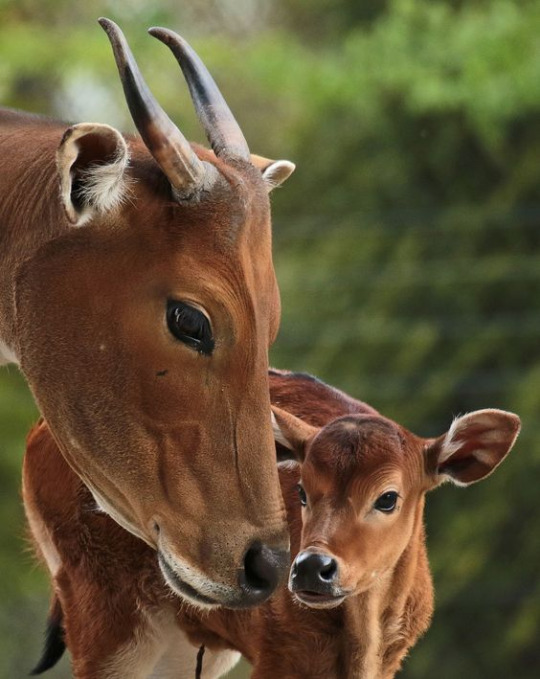
5 notes
·
View notes
Link
3 notes
·
View notes
Note
“Let’s see pirates sail from island to island looking for treasure right? They usually have pet parrots and the ship captain is almost always a big bearded guy who’s not always so nice to kids ah not that I think you’re mean at all Josep-San.” Kaban’s view of piracy is certainly limited to stereotypes you might find on a kids cartoon

Josep chuckles. "Well, as much as there are usually some sort of truth to the myths, in the case of pirates they're misunderstood or oversimplification of what was happening at the time.

"If one is to speak of the Golden Age of piracy.... well, for the most part, the exotic animal trade was surely a thing. To have a parrot would boast to anyone that this particular pirate would have been to the New World or some 'exotic' part of the Old World--hence, to have such a parrot would be a symbol of status. But as any parrot-keeper would tell you, they're not exactly high-maintenance, so you can't keep a parrot, or monkey, or some other exotic wild animal like one can keep a cat or a dog. And besides, you'll need to take into account feeding and cleaning up after them. So an everyday pirate who may have to rob others for food and soap would be highly unlikely to keep a parrot.
"As for beards, that depends on the time period and location. If we are speaking of the Caribbean and parts of Europe during the Golden Age of Piracy, the standard of fashion for men at the time in regards to beards is actually being clean-shaven. I don't recall if Edward Teach started his pirate career actually beardless before he would weaponize his eventual beard when going out in raids. Either way, from the 1600s-1700s, having large facial hair was falling out of fashion for men of the time, and any man with resources and self-respect would keep their face clean-shaven. Just as today where society would expect men to have their hair short and facial hair at least trimmed, the expectation back then was long but kept hair and a clean face. So you wouldn't come across too many pirates with beards. I don't keep a beard. I never liked having facial hair. So I would appear more typical of the time. Rashid is a notable exemption because he's an Arabian pirate, so the fashion of his time and place are different from those of European descent in the Caribbean.

"As for treasure hunting... it's not like what the books and movies make it out to be. Actual treasure hunting--as in going from island to island to search for lost goods--would look less like fancy-hatted adventurers with treasure maps and more like everyday chumps before the time of metal-detectors. In the Caribbean, if we did go actual treasure hunting, more than likely we'll go where we know a ship battle has taken place and search the general area for dropped goods, usually with a diving bell. I suppose it can be a career in itself, but it's not as fun or exciting as it sounds. It can get really tedious and exhausting. And not all ships that sink have something of value."
#correct me if I'm wrong OOC I'm mostly recalling on the top of my head what I read/watched about actual pirate facts of the time#[Captain Josep Frascona]#thesafaribaggirl returns
1 note
·
View note
Text
I Just Got a Rabbit. How Can I Take Care of It?
House rabbits are lovely animals to add to your family, but similarly to a cat or dog, they need just as much care as any other pet. Here are some ways you can take care of your new rabbit.
Purchase the Right Supplies!
But a LARGE cage for your rabbit to MOVE.
The rabbit may be outside SOME of the time, but MOST of the time the rabbit will be inside its cage. Purchase one where it is large enough so they can move around in, sleep in and run to if they feel fear, uncomfortable, etc.
Purchase bedding to cover the cage bottom.
Beddings vary, so try to experiment with different types to see what your rabbit likes. Shredded paper, straw, hay, etc. are the common types of bedding. Avoid wood shavings or such to prevent unnecessary injuries to your rabbit.
You NEED a rabbit litter box.
Indoor animal, indoor litter. There isn’t a perfect one, as some may need boxes with covers, the height may vary, etc. Try using a cat litter box as a start, and either build up to a different one or continue to use the same one.
Purchase a heavyweight bowl.
A heavy-material bowl, possibly ceramic, is a good bowl to get for your rabbit. This helps in preventing the unintentional spilling of food, so it is good to get these types of bowls. A little tip: use the goldilocks method for some of the bowls (it should be JUST THE RIGHT size for your rabbit).
WATER IS KEY!
If you have a rabbit, you are getting the water with the cages, but it is good to have water bowls around just in case.
Feed your rabbit plenty of hay.
Grass and hay are common foods for rabbits, which is what they are supposed to digest. It is important to use hay and grass so that they have all the nutrients they need. Remember to NOT overdo the eating of your rabbit.
Do You Have Time, Attention, and Money?!
Make Sure you have Time and Energy for your Rabbit
They are not low maintenance, as they require a lot of time, money, attention, resources, etc. similar to cats and dogs. Rabbits have their own personalities just like any other animal. You must think about this when making the decision to choose a rabbit.
Bond With Them
After Bringing your Rabbit Home; Observe Them
Watch how your rabbit interacts with your home. Where it uses the bathroom, how they react to others in the house, their reaction to toys, etc. If they sit and stay in a corner for a while, do not worry, or walk over it.
Let Your Rabbit Interact with You First!
Don’t rush this lovely relationship, allow the rabbit to come to you, and slowly interact with them. Speak to them in a soft voice, as they may be quite shy or nervous when they come around you. Offer them a vegetable (NOT CARROTS) as they are coming closer to you.
DO NOT play or touch your rabbit while they are eating!
Once you are feeding it, do not stroke it while it is eating, ONLY AFTER they are finished eating. Remember that they are prey in the wild, so they will run away and get defensive if they are touched while they are eating.
Keep them Safe and Healthy
Ensure that you have a vet whom you are able to check up with so that you can give your rabbit the appropriate help needed, one who has a wealth of experience with rabbits and other related animals. Once found, take them to the vet and arrange regular check-ups for your rabbit.
Don't Cuddle Too Much
While they are adorable bundles of love, they are afraid of being touched or hugged heavily. They are prey in the wild, and if they are pressed up against you for long periods of time, they will get skittish and very defensive and scared. Don’t overdo it.
#animals#nature#animal#wildlife#love#pets#cute#photography#pet#dog#cats#naturephotography#dogs#instagram#cat#rabbit#animallovers#photooftheday#dogsofinstagram#birds#petsofinstagram#animalsofinstagram#of#instagood#art#catsofinstagram#animalphotography
0 notes